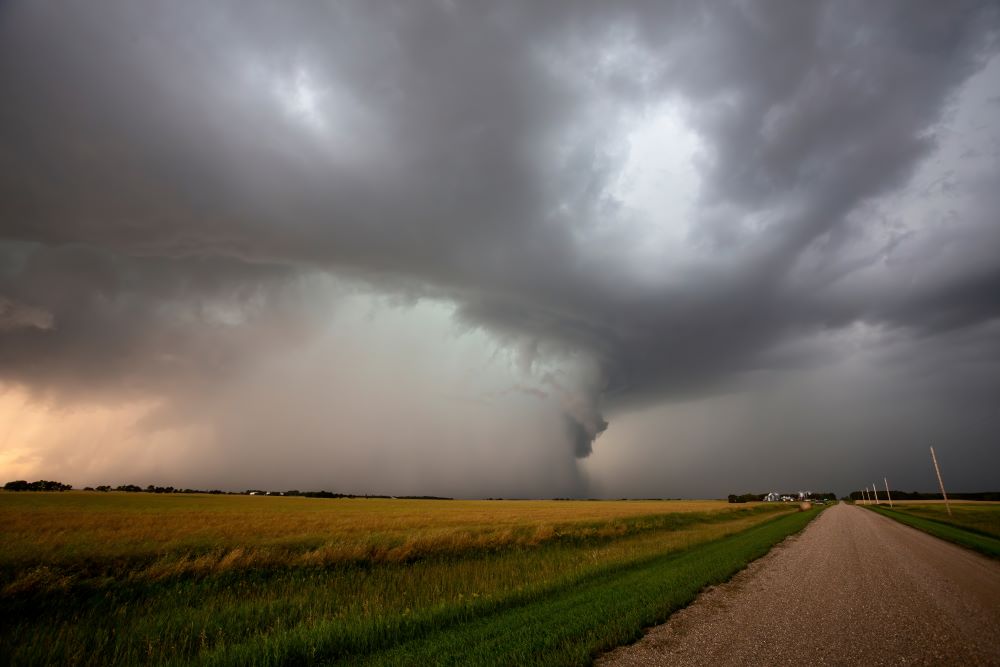Summer Storms – Preparedness on The Prairies
Summer Storms – Preparedness on The Prairies
Posted on July 12, 2023
By: Melanie Zukowski, Safety Trainer
Is any phrase more Canadian than, “if you don’t like the weather, just wait 5 minutes”? From the sunbaked west coast to the windy east coast, Canadian weather is a marvel to behold, and an unpredictable thorn in our sides.
During summer on the Prairies, the beautiful clear blue skies we’re known for can give way to some extreme weather – that you should know how to handle! And, if you’ve been paying attention to the weather app on your phone, or gone outside in Manitoba at all this summer, you’re aware of the bi-weekly weather alerts we’ve been experiencing.
Let us give you the Coles notes: here are the weather systems you’re most likely to run into on the prairies and what you can do to be prepared.
THUNDERSTORMS
As temperatures and humidity increase, so does the risk for thunderstorms. These storms often produce hail, high winds, heavy rain, and tornadoes. The heat generated by lightning causes an explosive expansion of air, which produces the noise of thunder.
To stay safe during a thunderstorm, use the 30-30 rule: count the seconds between the flash of lightning and the clap of thunder. Each second represents roughly 300 meters. If you count less than 30 seconds between lightning and thunder, the storm is less than 10km away, with an 80 per cent chance that the next lightning strike could be within that 10km radius. This is your indicator that it’s time to take shelter indoors.
In the case of a lightning storm, stay away from windows and doors, and avoid showering or bathing. Remain in the sheltered area for 30 minutes after the last clap of thunder. If you are outdoors and going indoors isn’t an option, find a depressed area like a ditch, or thick, low tree cover. Avoid tall objects and small structures (sheds, gazebos, outhouses), as well as open areas. Stay away from anything metal, water, and maintain at least 5m distance from other people. If hail is in the forecast, consider moving valuables (and yourself) to a covered location if possible and stay away from skylights.
If lightning is about to strike (feeling your hair stand on end is a strong indicator), make yourself as small a target as possible, and minimize contact with the ground – squat in a ball-like position, put your head between your knees and put your hands over your ears. Do not lie flat on the ground.

TORNADOES
Not every thunderstorm produces a tornado, but every tornado is preceded by a thunderstorm.
In June 2007, an EF5 tornado touched down in Elie, MB. It holds the record as the strongest tornado to ever touch down in Canada, causing almost $40 million in damage in its 35-minute lifespan. Tornadoes are most probable between May and August, with occurrence most likely in June and July. Warning signs include: an extremely dark sky, sometimes with green or yellow clouds, a rumbling or whistling sound, or a funnel cloud forming at the base of a thundercloud.
Manitoba averages around 8-12 tornadoes a year and due to increasing detection methods, including doppler weather radar and satellite imagery, the number of confirmed tornadoes has increased in recent years. In fact, southern parts of the Prairies, and Ontario are even known as “Tornado Alley”. While Ontario, Alberta and Saskatchewan see higher numbers of tornadoes, Manitoba sees stronger tornadoes, on average.
To stay safe in a tornado, take shelter in the lower level of a sturdy building, under a stairwell, a sturdy table, or in an interior room. Stay away from windows and doors and avoid wide-span buildings, like barns. Do not take shelter in vehicles or mobile homes, which the tornado can potentially lift. If you are outdoors, lie flat in a ditch or low-lying area, and shield your head with your arms.
BE PREPARED FOR THE FALLOUT
Extreme weather can have extreme after-effects. In the event of a severe weather event, you may experience power outages, hail damage or even basement flooding. It’s important to be prepared so you’re not left out in the rain. Consider your area: an urban area might have better access to community services and support (a community centre may be able to provide showers, clean water, and a power source to charge devices during an extended power outage). However, a more remote or rural community may have a larger window for those services to be reached.
Your emergency kit or supplies should equip you to be self-sufficient for a minimum of 72 hours, but that need may be longer, depending on your area (see our Flood Preparedness Blog for more info on emergency kits: https://madesafe.ca/2023/05/03/emergency-preparedness-spring-storms-and-flooding/). Check with your local emergency or government services if you have questions about access to services and prepare accordingly.
If you are planning outdoor adventures this summer, like boating or camping, share your route and expected departure and return times. When setting up a tent or trailer, refer to the ‘outdoor’ thunderstorm safety guidelines to ensure you have picked an optimally safe outdoor location. Check your weather forecast and watch for changes periodically.
The Government of Canada has a Lightning Danger map, which indicates where the risk of being struck by lightning currently exists. Find it here: https://weather.gc.ca/lightning/index_e.html.
For more information on how to protect yourself from severe weather in Manitoba, visit: https://www.gov.mb.ca/severeweather/index.html
There is no place outside that is safe in a thunderstorm, so remember:
When thunder roars, go indoors!
